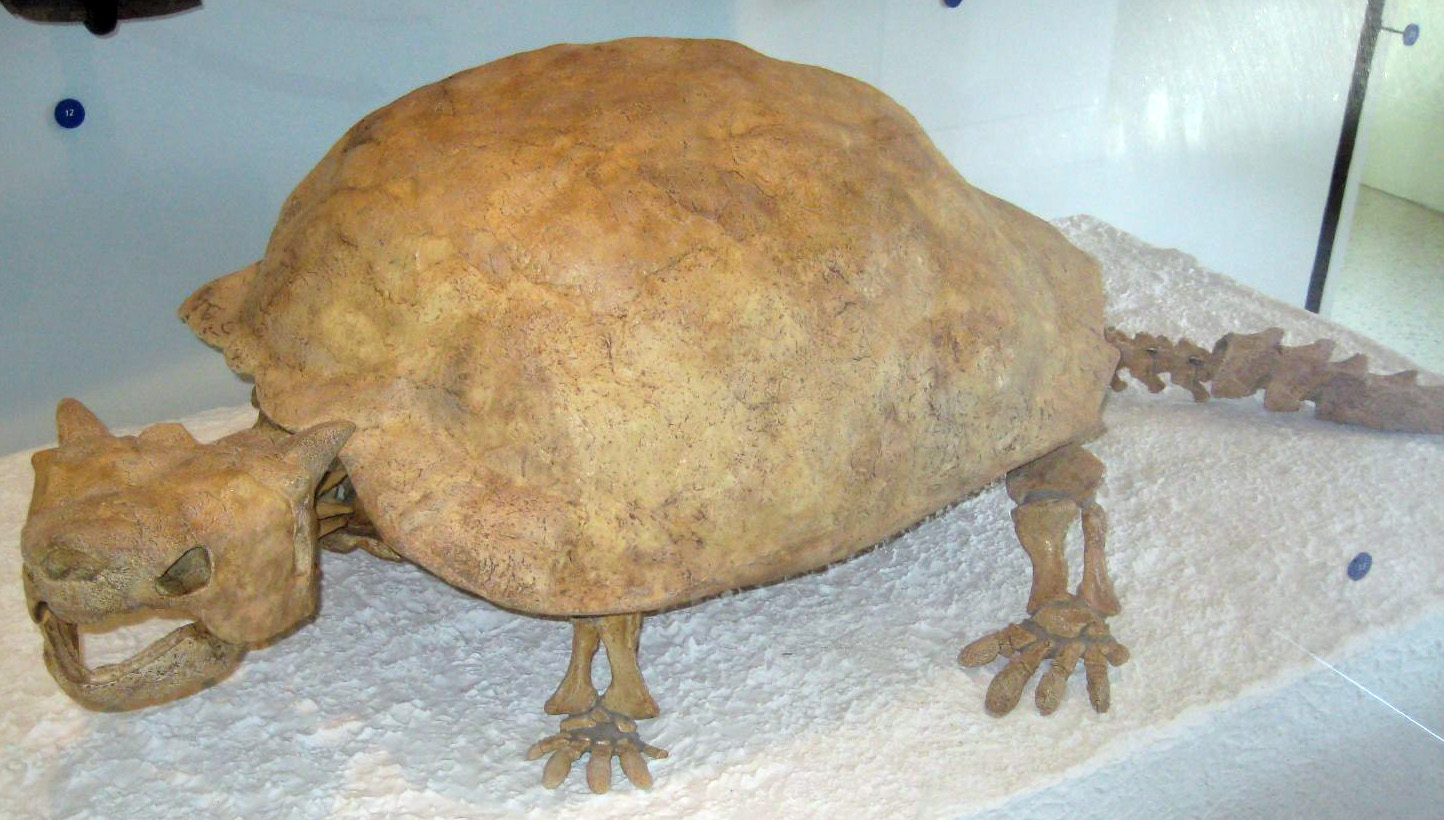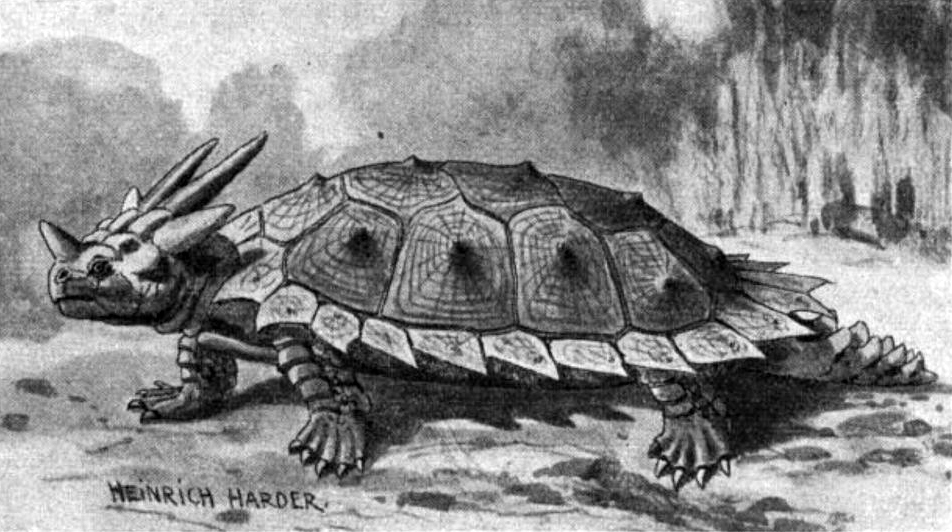|
Meiolaniid
Meiolaniidae is an extinct family of large, probably herbivorous stem-group turtles with heavily armored heads and tails known from South America and Australasia. Though once believed to be cryptodires, they are not closely related to any living species of turtle, and lie outside crown group Testudines, having diverged from them around the Middle Jurassic. They are best known from the last surviving genus, ''Meiolania'', which lived in the rain forests of Australia from the Miocene until the Pleistocene, and insular species that lived on Lord Howe Island and New Caledonia during the Pleistocene and possibly the Holocene for the latter. Meiolaniids are part of the broader grouping of Meiolaniformes, which contains more primitive turtles species lacking the distinctive morphology of meiolaniids, known from the Early Cretaceous-Paleocene of South America and Australia. A similar form is also known from the Miocene Saint Bathans fauna of New Zealand. Meiolaniids reached total le ... [...More Info...] [...Related Items...] OR: [Wikipedia] [Google] [Baidu] |
Meiolania Platyceps
''Meiolania'' ("small roamer") is an extinct genus of meiolaniid stem-turtle native to Australasia from the Middle Miocene to Late Pleistocene and possibly Holocene. It is best known from fossils found on Lord Howe Island, though fossils are known from mainland Australia, New Caledonia, and possibly Vanuatu and Fiji. Taxonomy The genus was erected in 1886 based on remains found on Lord Howe Island, which Richard Owen assigned to the two species ''M. platyceps'' and ''M. minor'' (now a synonym of the former). These were the first good meiolaniid remains, and were used to show that the first known remains of a related animal, a species from Queensland now known as '' Ninjemys oweni'' (which was assigned to ''Meiolania'' until 1992), did not belong to lizards as initially thought, but to turtles. Woodward sank '' Niolamia argentina'' into ''Meiolania'', but this was not accepted by later authors. The species of the genus may be summarized as In New Caledonia, ''M. mack ... [...More Info...] [...Related Items...] OR: [Wikipedia] [Google] [Baidu] |
Meiolania
''Meiolania'' ("small roamer") is an extinct genus of meiolaniid stem-turtle native to Australasia from the Middle Miocene to Late Pleistocene and possibly Holocene. It is best known from fossils found on Lord Howe Island, though fossils are known from mainland Australia, New Caledonia, and possibly Vanuatu and Fiji. Taxonomy The genus was erected in 1886 based on remains found on Lord Howe Island, which Richard Owen assigned to the two species ''M. platyceps'' and ''M. minor'' (now a synonym of the former). These were the first good meiolaniid remains, and were used to show that the first known remains of a related animal, a species from Queensland now known as '' Ninjemys oweni'' (which was assigned to ''Meiolania'' until 1992), did not belong to lizards as initially thought, but to turtles. Woodward sank ''Niolamia argentina'' into ''Meiolania'', but this was not accepted by later authors. The species of the genus may be summarized as In New Caledonia, ''M. mackayi'' was ... [...More Info...] [...Related Items...] OR: [Wikipedia] [Google] [Baidu] |
Ninjemys
''Ninjemys oweni'' ("Owen's Ninja Turtle") is an extinct large meiolaniid stem-turtle from Pleistocene Queensland (Australia). It resembled its relative, ''Meiolania'', save that the largest pair of horns on its head stuck out to the sides, rather than point backwards. It is only known from a mostly complete skull and the distal portion of a tail. Discovery and taxonomy The remains of ''Ninjemys'' were found at the King's Creek locality in Queensland in 1879 by G. F. Bennett, an Australian collector. The King's Creek deposit is believed to be of Pleistocene age, though the precise dating is uncertain. Despite the fact that Bennett correctly identified the remains as that of a turtle, when they were sent to the Natural History Museum, Richard Owen mixed up the remains with the vertebrae of ''Megalania'', and subsequently with the foot bones of ''Diprotodon''. He later described better remains of the related genus ''Meiolania'' from Lord Howe Island, so it was realised that this ... [...More Info...] [...Related Items...] OR: [Wikipedia] [Google] [Baidu] |
Saint Bathans Fauna
The St Bathans fauna is found in the lower Bannockburn Formation of the Manuherikia Group of Central Otago, in the South Island of New Zealand. It comprises a suite of fossilised prehistoric animals from the late Early Miocene (Altonian) period, with an age range of 19–16 million years ago. The layer in which the fossils are found derives from littoral zone sediments deposited in a shallow, freshwater lake, with an area of 5600 km2 from present day Central Otago to Bannockburn and the Nevis Valley in the west; to Naseby in the east; and from the Waitaki Valley in the north to Ranfurly in the south. The lake was bordered by an extensive floodplain containing herbaceous and grassy wetland habitats with peat-forming swamp–woodland. At that time the climate was warm with a distinctly subtropical Australian climate and the surrounding vegetation was characterised by casuarinas, eucalypts and palms as well as podocarps, araucarias and southern beeches. The fossilifero ... [...More Info...] [...Related Items...] OR: [Wikipedia] [Google] [Baidu] |
Niolamia
''Niolamia'' is an extinct genus of South American meiolaniid turtle. Arthur Smith Woodward classified it as being in the genus ''Meiolania'', which this genus name is an anagram of, but this was not accepted by later authors. The genus is known from the Sarmiento Formation in Argentina Argentina (), officially the Argentine Republic ( es, link=no, República Argentina), is a country in the southern half of South America. Argentina covers an area of , making it the second-largest country in South America after Brazil, th ....''Niolamia'' at Fossilworks.org ''Crossochelys'' was found to be a synonym in a review of South American Turtles. [...More Info...] [...Related Items...] OR: [Wikipedia] [Google] [Baidu] |
Warkalania
''Warkalania'' is an extinct genus of Australian meiolaniid turtle from the Oligocene or early Miocene of Riversleigh, Queensland ) , nickname = Sunshine State , image_map = Queensland in Australia.svg , map_caption = Location of Queensland in Australia , subdivision_type = Country , subdivision_name = Australia , established_title = Before federation , establishe .... It is unique among this group in having small, low ridges instead of long horns. References Oligocene turtles Miocene turtles Meiolaniformes Riversleigh fauna Prehistoric turtle genera Taxa named by Eugene S. Gaffney Extinct turtles {{paleo-turtle-stub ... [...More Info...] [...Related Items...] OR: [Wikipedia] [Google] [Baidu] |
Sarmiento Formation
The Sarmiento Formation (Spanish: ''Formación Sarmiento''), in older literature described as the Casamayor Formation, is a geological formation in Chubut Province, Argentina, in central Patagonia, which spans around 30 million years from the mid-Eocene to the early Miocene. It predominantly consists of pyroclastic deposits, which were deposited in a semi-arid environment. It is divided up into a number of members. The diverse fauna of the Sarmiento Formation, including a variety of birds, crocodilians, turtles and snakes, also includes many mammals such as South American native ungulates (notoungulates, litopterns, astrapotheres) as well as armadillo Armadillos (meaning "little armored ones" in Spanish) are New World placental mammals in the order Cingulata. The Chlamyphoridae and Dasypodidae are the only surviving families in the order, which is part of the superorder Xenarthra, along wi ...s, and caviomorph rodents. Material was copied from this source, which is availabl ... [...More Info...] [...Related Items...] OR: [Wikipedia] [Google] [Baidu] |
Eocene
The Eocene ( ) Epoch is a geological epoch (geology), epoch that lasted from about 56 to 33.9 million years ago (mya). It is the second epoch of the Paleogene Period (geology), Period in the modern Cenozoic Era (geology), Era. The name ''Eocene'' comes from the Ancient Greek (''ēṓs'', "dawn") and (''kainós'', "new") and refers to the "dawn" of modern ('new') fauna that appeared during the epoch. The Eocene spans the time from the end of the Paleocene Epoch to the beginning of the Oligocene Epoch. The start of the Eocene is marked by a brief period in which the concentration of the carbon isotope Carbon-13, 13C in the atmosphere was exceptionally low in comparison with the more common isotope Carbon-12, 12C. The end is set at a major extinction event called the ''Grande Coupure'' (the "Great Break" in continuity) or the Eocene–Oligocene extinction event, which may be related to the impact of one or more large bolides in Popigai impact structure, Siberia and in what is now ... [...More Info...] [...Related Items...] OR: [Wikipedia] [Google] [Baidu] |
New Zealand
New Zealand ( mi, Aotearoa ) is an island country in the southwestern Pacific Ocean. It consists of two main landmasses—the North Island () and the South Island ()—and over 700 smaller islands. It is the sixth-largest island country by area, covering . New Zealand is about east of Australia across the Tasman Sea and south of the islands of New Caledonia, Fiji, and Tonga. The country's varied topography and sharp mountain peaks, including the Southern Alps, owe much to tectonic uplift and volcanic eruptions. New Zealand's capital city is Wellington, and its most populous city is Auckland. The islands of New Zealand were the last large habitable land to be settled by humans. Between about 1280 and 1350, Polynesians began to settle in the islands and then developed a distinctive Māori culture. In 1642, the Dutch explorer Abel Tasman became the first European to sight and record New Zealand. In 1840, representatives of the United Kingdom and Māori chiefs ... [...More Info...] [...Related Items...] OR: [Wikipedia] [Google] [Baidu] |
South America
South America is a continent entirely in the Western Hemisphere and mostly in the Southern Hemisphere, with a relatively small portion in the Northern Hemisphere at the northern tip of the continent. It can also be described as the southern subregion of a single continent called America. South America is bordered on the west by the Pacific Ocean and on the north and east by the Atlantic Ocean; North America and the Caribbean Sea lie to the northwest. The continent generally includes twelve sovereign states: Argentina, Bolivia, Brazil, Chile, Colombia, Ecuador, Guyana, Paraguay, Peru, Suriname, Uruguay, and Venezuela; two dependent territories: the Falkland Islands and South Georgia and the South Sandwich Islands; and one internal territory: French Guiana. In addition, the ABC islands of the Kingdom of the Netherlands, Ascension Island (dependency of Saint Helena, Ascension and Tristan da Cunha, a British Overseas Territory), Bouvet Island ( dependency of Norway), Pa ... [...More Info...] [...Related Items...] OR: [Wikipedia] [Google] [Baidu] |
Argentina
Argentina (), officially the Argentine Republic ( es, link=no, República Argentina), is a country in the southern half of South America. Argentina covers an area of , making it the second-largest country in South America after Brazil, the fourth-largest country in the Americas, and the eighth-largest country in the world. It shares the bulk of the Southern Cone with Chile to the west, and is also bordered by Bolivia and Paraguay to the north, Brazil to the northeast, Uruguay and the South Atlantic Ocean to the east, and the Drake Passage to the south. Argentina is a federal state subdivided into twenty-three provinces, and one autonomous city, which is the federal capital and largest city of the nation, Buenos Aires. The provinces and the capital have their own constitutions, but exist under a federal system. Argentina claims sovereignty over the Falkland Islands, South Georgia and the South Sandwich Islands, and a part of Antarctica. The earliest recorded human prese ... [...More Info...] [...Related Items...] OR: [Wikipedia] [Google] [Baidu] |





